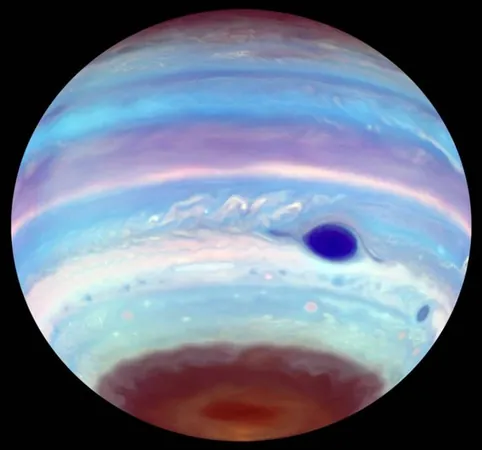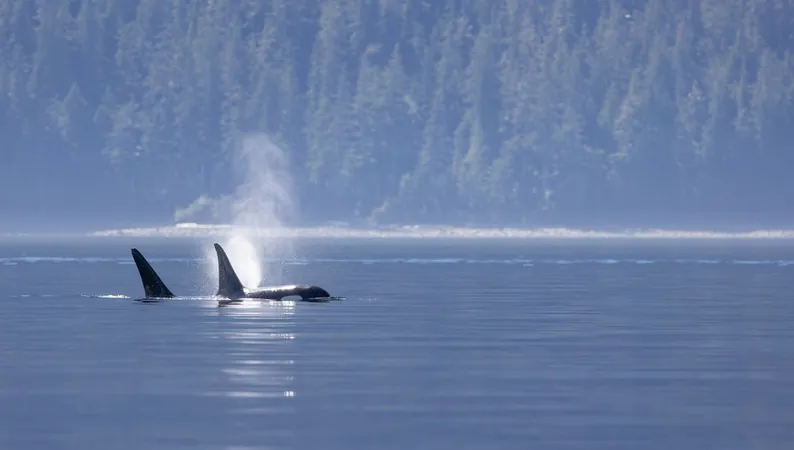
Mysterious Dark Storms Larger Than North America Discovered at Jupiter’s Poles!
2025-04-13
Author: Li
Strange Shadows in the Skies of Jupiter
In a groundbreaking discovery, scientists have spotted enigmatic, dark vortices swirling above Jupiter’s poles—massive formations visible only in ultraviolet light that appear and dissipate like fleeting specters. These discoveries are reshaping our understanding of the dynamic interplay between Jupiter’s magnetic field and its atmosphere.
A Dance of Darkness and Light
Led by researchers from the University of California, the team found these peculiar dark ovals predominantly near Jupiter's south pole, emerging in roughly half of the UV images analyzed. Astonishingly, the southern dark oval occurs four to six times more frequently than its northern counterpart.
Unlocking the Secrets Through UV Vision
The findings, published in the esteemed journal *Nature Astronomy*, stem from an extensive analysis of decades worth of ultraviolet images captured by the Hubble Space Telescope. Scientists theorize that these dark phenomena materialize when the haze in Jupiter’s atmosphere becomes significantly denser—up to 50 times thicker than usual.
Twisting and Turning—What Lies Beneath?
These dark ovals seem to be extensions of previously identified vortices in Jupiter’s upper atmosphere, spiraling down into the stratosphere in a counterclockwise rotation, contrasting with the lighter clouds visible in normal light. This revelation hints at a more complex atmospheric interaction occurring beneath the planet’s stunning auroras.
A 28-Year Exploration through Cosmic Archives
Over a 28-year period, researchers meticulously examined 26 global maps of Jupiter, revealing that these dark ovals can emerge within just 31 days and might linger for up to 82 days. Fascinatingly, most dark ovals were found nestled within the planet’s main auroral oval, where charged particles create intense glowing displays.
The Polar Puzzle: North vs. South
The southern dark oval, often massive and reminiscent of North America in size, consistently forms in a specific location near the south pole. What remains perplexing is the stark difference in occurrence between the southern and northern hemispheres. Researchers propose that this could be linked to the unique alignment of Jupiter’s magnetic field with its rotational axis, favoring conditions for these dark vortices to thrive in the southern hemisphere.
A Symphony of Winds: How Storms Connect
These revelations underscore the interconnectedness of Jupiter’s upper and lower atmospheres, with swirling winds from high altitudes reaching down to stir up haze, rendering the dark storms visible beneath UV light. Researchers liken this phenomenon to a tornado stirring dust on Earth, showcasing the striking visual effects of atmospheric dynamics.





 Brasil (PT)
Brasil (PT)
 Canada (EN)
Canada (EN)
 Chile (ES)
Chile (ES)
 Česko (CS)
Česko (CS)
 대한민국 (KO)
대한민국 (KO)
 España (ES)
España (ES)
 France (FR)
France (FR)
 Hong Kong (EN)
Hong Kong (EN)
 Italia (IT)
Italia (IT)
 日本 (JA)
日本 (JA)
 Magyarország (HU)
Magyarország (HU)
 Norge (NO)
Norge (NO)
 Polska (PL)
Polska (PL)
 Schweiz (DE)
Schweiz (DE)
 Singapore (EN)
Singapore (EN)
 Sverige (SV)
Sverige (SV)
 Suomi (FI)
Suomi (FI)
 Türkiye (TR)
Türkiye (TR)
 الإمارات العربية المتحدة (AR)
الإمارات العربية المتحدة (AR)